
 |
State and Regional EconomicDevelopments in CaliforniaPart I |
Introduction |
After experiencing a major recession in the early 1990s, California has recently been enjoying healthy and diverse
economic growth. While the state faces near-term challenges related to international developments and softness in
its electronics manufacturing industries, its longer-term outlook appears to be positive. This report examines
recent economic developments in California, with special emphasis on how the state's major geographic economic
regions have been faring. It also looks at the near-term outlook for the state and its economic regions.
| |
Table of Contents |
California's Statewide PictureRegional Developments in CaliforniaTrends in the Southern California Economic RegionTrends in the San Francisco Bay Area Economic RegionTrends in the Central Valley Economic RegionTrends in the Central Coast Economic RegionTrends in the Rest-of-the-State Economic RegionImplications of California's Renewed Economic Growth |
California's $1 trillion-plus economy--the seventh largest in the world--has experienced a number of major changes during the past decade. It has seen the deepest recession in over a half century, along with the permanent downsizing of some major industries such as aerospace, construction, finance, and utilities. More recently, the state has experienced major gains in other industries--in particular, those related to high technology manufacturing and services, movie production, multimedia activities, tourism, apparel, and international trade.
The experience of individual workers and businesses during this recent period of economic change and transition has been mixed. Some, for example, have benefitted from the new opportunities that California's changing economy has brought forth. Others, caught in the numerous industrial dislocations, downsizings, and restructurings that have occurred, have faced difficult circumstances. Indeed, some workers face permanently lowered job and income prospects.
Despite the lingering problems associated with the state's restructurings, California's economy as a whole has fully recovered from its period of economic malaise. Broad measures such as aggregate employment, income, and sales activity are at new highs and have been expanding at above-average rates, signifying that California has finally regained its role as a national and international economic leader.
Recent Job Growth Has Surged. Figure 1 provides a general picture of California's "roller coaster" economic performance in the 1990s. Among other things, it indicates that:
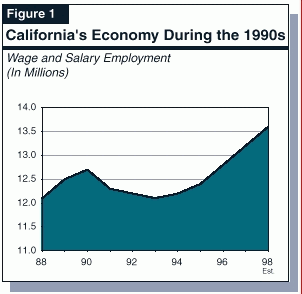
The 1990s' Expansion Got Stronger as It Aged. In past decades, the early stages of economic expansions have traditionally been characterized by rapid growth, due to major gains in the residential construction, retail trade, and durable goods manufacturing industries. These rapid early stages were generally followed by more moderate growth periods, as the expansions matured and the pace of spending by households and businesses eventually settled down into somewhat slower, more sustainable rates.
In sharp contrast to these past experiences, the early stages of the current expansion were characterized by modest economic growth, with employment and income growing at less than one-half the rates of earlier expansions. This was partly due to the continued cutbacks in defense-related aerospace industries, ongoing restructurings in finance and communications industries, and softness in housing activity (with the latter having persisted well into 1996).
More recently, however, the state's expansion began to broaden and strengthen, as the restructurings began to subside
and the real estate markets perked up. Employment and income growth in the state surpassed the national average in 1996 for the first time since 1989. These
positive trends accelerated in 1997 and remained strong through the first half of 1998. Over the past two years, meaningful employment growth has spread to
virtually all major geographical regions and industry sectors in the state. Other economic indicators confirm these trends, such as home sales, nonresidential
construction activity, taxable sales, and weekly hours and earnings in the manufacturing sector.
Recent Growth Has Been Broad Based. As indicated in Figure 2, nearly all of the state's major sectors added jobs through the first half of 1998. The state's
services sector has contributed over 200,000 jobs over the past yearnearly one-half of the total gain. In percentage terms, the fastest growing industry has been
construction, which is benefitting from increases in both residential and nonresidential building activity. Other industries posting significant gains include trade
and manufacturing.
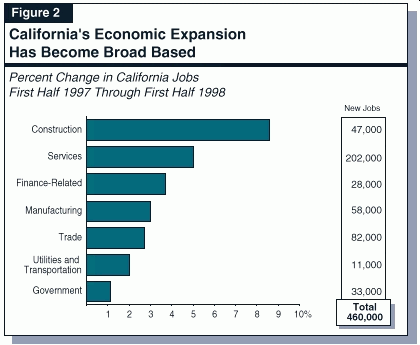
Wage and Salary Employment CategoriesEmployment data provide the most current and comprehensive information on industry trends in the state. These data are collected monthly by the state's Employment Development Department (EDD) from businesses in California, and are categorized by industry sector based on the Standard Industrial Classification (SIC). The major nonagricultural categories are:
|
The emergence of broad-based economic growth has very positive implications for California. The state's diverse industry mix makes our economy currently more stable and less vulnerable to downturns in one or two key industries than it has been in the past, such as in the late 1980s when the economy was highly dependent on defense and real estate-related spending.
What About the Impact of Asia's Problems? An important factor affecting California's near-term economic outlook is the economic and financial problems occurring in East Asia (this area includes Malaysia, Thailand, Indonesia, the Phillippines, South Korea, Taiwan, Singapore, Hong Kong, Japan, and China). The decline in currency values and the weakening economies in the emerging Asian areas are having significant adverse impacts on U.S. trade, and these impacts are expected to become more pronounced during the second half of 1998. The announcement of a deeper-than-expected economic downturn in Japan has added to concerns about the impact of Asia's problems on U.S. international trade. California is particularly vulnerable to slowdowns in Asia, due to the larger-than-average share of California's goods and services that are exported to that region. As indicated in Figure 3, nearly one-half of total California exports are to Japan and other East Asian Countries.
So far, the impacts of Asia's problems on California have been fairly modest. Although exports to several East Asian countries have fallen over the past year, these reductions have thus far been offset by growth in other markets, particularly Mexico and Europe. However, the full impact of the Asian crisis on California is still not known and remains to be seen. It may be the case that, because of contractual arrangements and other factors, a time lag has simply been experienced between the onset of Asia's financial problems and the associated reductions in orders for California-produced goods that will follow. Indeed, more current national trade-related data suggest that some negative effects are now beginning to appear, and company profit reports indicate that some California businesses with significant Asian markets are experiencing sales and profit slowdowns. The more serious these slowdowns become, the more serious will be the implications for California's high technology industries, which export significant amounts of goods and services to these countries.
At this point, however, the "best guess" is that, while Asia's problems will cause a slowdown in the U.S. and California economic expansions, especially in late
1998 and early 1999, their negative effects will not be severe enough to derail our economies.
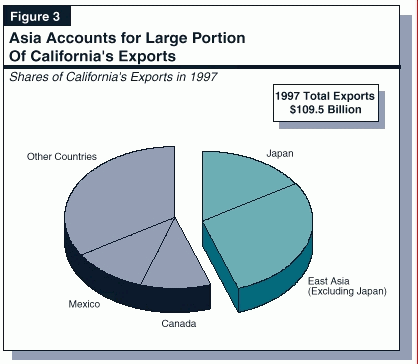
Business Services Growth Reflective of Several TrendsThroughout California, one of the fastest growing industries in the current economic expansion has been business services. Since the category of business services has traditionally included many temporary and lower-paying services-related jobs, some observers have expressed concern that the rapid growth in this sector is evidence that the underlying foundations of the current economic expansion are not all that strong. While some of the growth in business services is indeed related to a rise in temporary employment service jobs, this category also includes a significant number of highly skilled, highly paid, and permanent jobs. For example, nearly one-third of the growth in the business services category over the past several years has been related to jobs in high technology companies specializing in computer and systems design, computer hardware, and software development and services. The average pay level in these highly specialized industry categories is currently over $70,000 annually, or more than double the statewide average annual pay level for all industries (see accompanying figure). Another relatively high paying sector is advertising, with average incomes of over $45,000 annually. The growth in computer-related business services jobs reflects the growing importance of small and specialized businesses in California. Many of the design,
development, and support-related functions provided by employees in these service sectors would in the past have been performed by workers in larger, more
integrated manufacturing firms. A consequence of the emerging and evolving business services sector is that the historical distinction drawn between
"high-wage manufacturing jobs" and "low-wage service jobs" is becoming more and more blurred.
|
The Near-Term Outlook--Some Slowing, But Moderate Growth Ahead
Figure 4 provides our May forecast for California's economy from 1998 through 2000. The forecast assumed that the combination of Asia's economic problems and more modest growth in the U.S. economy will lead to a tapering in the rate of job and income growth in this state. As discussed below, the slowdowns will likely be most pronounced in Silicon Valley, which in recent years has been the fastest growing region of the state.
| Figure 4 | ||||
| Summary of LAO's May 1998 Economic Outlook | ||||
| Percent Changesa | ||||
| Preliminary 1997 | Projected | |||
| 1998 | 1999 | 2000 | ||
| United States Forecast | ||||
| Percent change in: | ||||
| Real GDP | 3.8 | 3.0 | 1.9 | 2.4 |
| Personal income | 5.8 | 5.4 | 4.0 | 4.3 |
| Wage and salary jobs | 2.3 | 2.6 | 1.0 | 1.1 |
| Consumer Price Index | 2.4 | 1.7 | 2.6 | 2.8 |
| Unemployment rate (%) | 5.0 | 4.7 | 5.1 | 5.3 |
| Housing Starts (000) | 1,478 | 1,514 | 1,431 | 1,425 |
| California Forecast | ||||
| Percent change in: | ||||
| Personal income | 7.3 | 7.1 | 5.8 | 5.4 |
| Wage and salary jobs | 3.3 | 3.4 | 2.9 | 2.5 |
| Taxable sales | 6.3 | 6.2 | 5.6 | 5.2 |
| Consumer Price Index | 2.2 | 2.1 | 2.8 | 3.0 |
| Unemployment rate (%) | 6.3 | 5.8 | 5.4 | 5.3 |
| New housing permits (000) | 111 | 130 | 153 | 157 |
| a Unless otherwise indicated. | ||||
Despite this easing though, California will likely continue to experience moderate economic expansion through the end of the decade, sustained in part by strength in construction, services, and retail trade activity. During this period, California's employment and income growth are expected to exceed the national average by about 1-to-2 percentage points per year.
Underlying California's aggregate economic developments in the 1990s have been varying economic performances within its individual major geographic regions. In this section, we review the state's regional economic developments during the 1990s, and discuss the regional aspects of the current statewide economic outlook. For purposes of this report, we have grouped California's counties into five broad regions, each of which has somewhat distinct economic and geographic characteristics. These regions, shown in Figure 5, are:
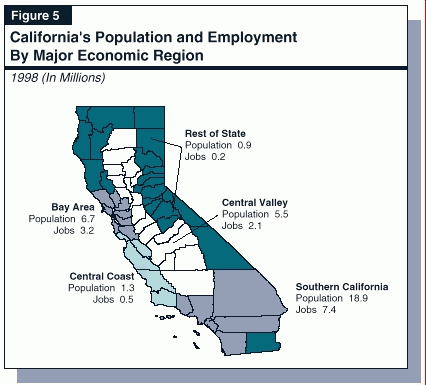
The state's overall economic fortunes in the 1990s--both positive and negative--have been substantially affected by developments in Southern California. For example, the severity of California's recession was due largely to major job losses in Southern California. Likewise, the more recent improvement in the state's overall economic growth can be traced to the acceleration of employment and other economic measures in Southern California's economy. To be sure, favorable economic developments in other regions in the recent past have had significant positive effects on the state's overall performance. For instance, booming economic activity in Silicon Valley clearly boosted California's overall economy in the mid-1990s. Nevertheless, the sheer size of Southern California has made it a dominant factor in California's overall 1990s' economic performance.
Figure 6 shows how the state's various individual geographic regions have performed in the 1990s. It shows that the recession that hit Northern California was moderate, with total jobs falling by less than 3 percent between mid-1990 and mid-1993. In contrast, the downturn in Southern California was severe, with total employment falling by over 7 percent during the same period.
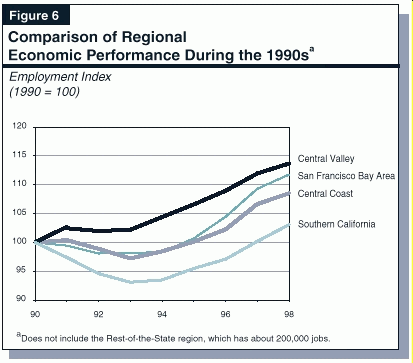
The figure also shows that employment turned upward earlier in Northern California than in Southern California and, until recently, the percentage rate of growth has been greater in the north than in the south. Finally, the figure shows that all regions except Southern California had surpassed their prerecession employment peaks by mid-1995, and have expanded an additional 10 percent to 15 percent since then. In contrast, Southern California did not recoup the jobs lost in the recession until last year, and today is just 3 percent above where it was at the beginning of the decade.
One reason for the regional variation in economic performance during the 1990s noted above relates to the large and growing presence of the high technology sector in the Silicon Valley, which has experienced booming economic conditions in recent years. Equally important, however, is Southern California's relatively greater exposure to the major downturns that occurred during the 1990s in aerospace and construction. This is illustrated in Figure 7, which shows that the majority of job losses in these two industry sectors occurred in Southern California.
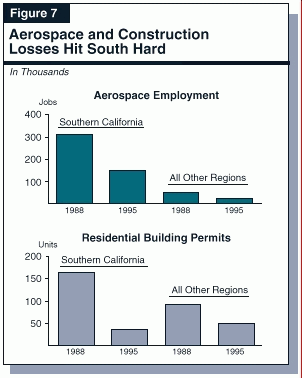
By 1996, the negative forces affecting Southern California had finally "run their course," paving the way for accelerating economic growth for California as a whole. As shown in Figure 8, most of the acceleration in statewide employment growth can be traced to Southern California. Specifically, the figure shows that:
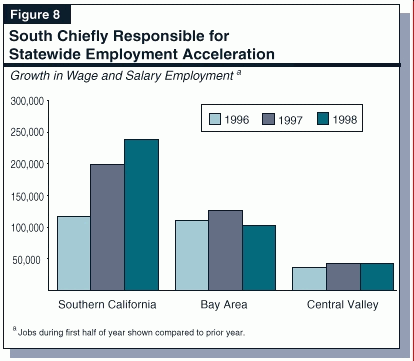
What's an MSA?Our discussion of economic developments within California's major economic regions concentrates on employment data that are compiled by the California Employment Development Department (EDD) for the state's Metropolitan Statistical areas (MSAs). An MSA is a contiguous area with a large population center and a high degree of economic integration. In most instances, the MSAs are identical to the corresponding county; thus, for example, we refer to the MSA and County of Los Angeles interchangeably in our report. However, in a few cases, the MSAs consist of two or more adjacent counties. Examples of multiple-county MSAs include Sacramento (which consists of Sacramento, Placer, and El Dorado Counties), Riverside/San Bernardino, and San Francisco (which consists of San Francisco, San Mateo, and Marin Counties). |
We believe that continued growth in Southern California will keep the state's economic expansion on track in the near-term future, offsetting some of the slowing that will likely occur in the San Francisco Bay Area in the coming year.
In the sections which follow, we look at the key factors behind the recent economic changes experienced within each of the state's individual major economic regions.